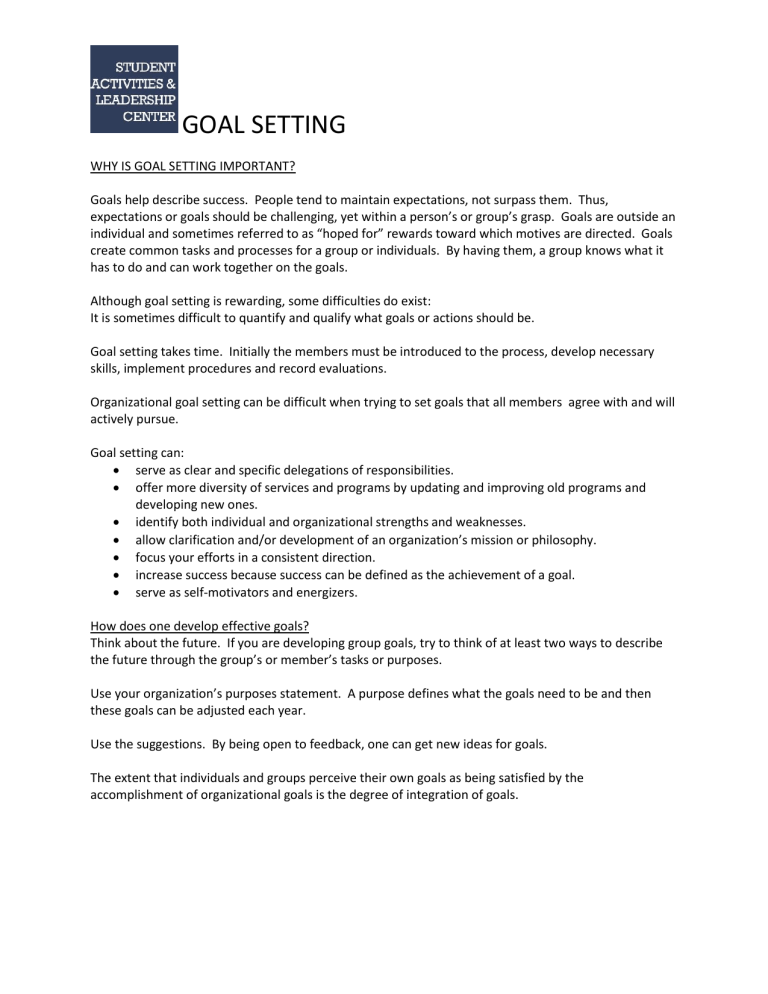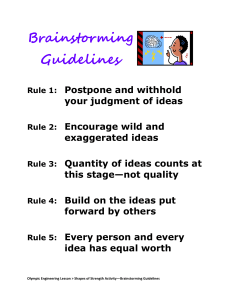
GOAL SETTING WHY IS GOAL SETTING IMPORTANT? Goals help describe success. People tend to maintain expectations, not surpass them. Thus, expectations or goals should be challenging, yet within a person’s or group’s grasp. Goals are outside an individual and sometimes referred to as “hoped for” rewards toward which motives are directed. Goals create common tasks and processes for a group or individuals. By having them, a group knows what it has to do and can work together on the goals. Although goal setting is rewarding, some difficulties do exist: It is sometimes difficult to quantify and qualify what goals or actions should be. Goal setting takes time. Initially the members must be introduced to the process, develop necessary skills, implement procedures and record evaluations. Organizational goal setting can be difficult when trying to set goals that all members agree with and will actively pursue. Goal setting can: serve as clear and specific delegations of responsibilities. offer more diversity of services and programs by updating and improving old programs and developing new ones. identify both individual and organizational strengths and weaknesses. allow clarification and/or development of an organization’s mission or philosophy. focus your efforts in a consistent direction. increase success because success can be defined as the achievement of a goal. serve as self-motivators and energizers. How does one develop effective goals? Think about the future. If you are developing group goals, try to think of at least two ways to describe the future through the group’s or member’s tasks or purposes. Use your organization’s purposes statement. A purpose defines what the goals need to be and then these goals can be adjusted each year. Use the suggestions. By being open to feedback, one can get new ideas for goals. The extent that individuals and groups perceive their own goals as being satisfied by the accomplishment of organizational goals is the degree of integration of goals. GOAL SETTING Process for brainstorming goals: Allow ideas to start goals. Members should begin to talk about what they would like the group to accomplish. Let every member take part in the brainstorming. This is important for morale and cohesion. Also, members are more likely to support what they help create. Unrealistic goals should not be weeded out until later. When finalizing the goals, make sure that they are measurable. After brainstorming, prioritize goals: Place goals in order of importance. This can be difficult because each member has individual ideas of what is important for the group. Break into small groups to prioritize goals concerning different segments of the organization. Have members rank the goals on their own and then share their ideas with the group to reach consensus. After goal setting, develop plans to achieve the goals so they are more than nice words. Types of Goals Short-Term Goals focus on performance require immediate action accomplish tasks and complete projects Long-Term Goals focus on potential are reachable by small steps build and develop individuals and organizations Develop an action plan: If you have more than one objective, start with the one that the group considers the most important or complex. Develop a detailed plan for fulfilling the objective by the target date. Identify what information not already available is needed to meet that objective. Identify the steps needed to accomplish the goal. Put the steps in the order they need to be done. Determine what individuals or groups in the organization will be involved in the implementation of the plan. Then decide who will be responsible for what phases of the action plan. Set a deadline for each step. Evaluate the goals or the people doing them periodically to check their progress and make sure members are working to achieve them. Conduct an evaluation of the goals by the end of the year. From the evaluation, make recommendations for next year’s group. By setting goals, developing action plans, working to fulfill them, and evaluating the process, you and your organization will be more likely to succeed in your tasks.

